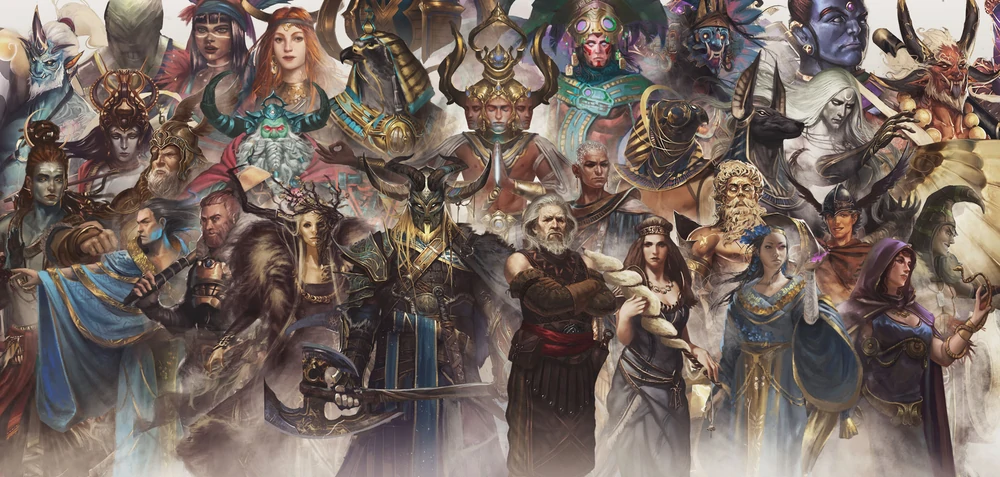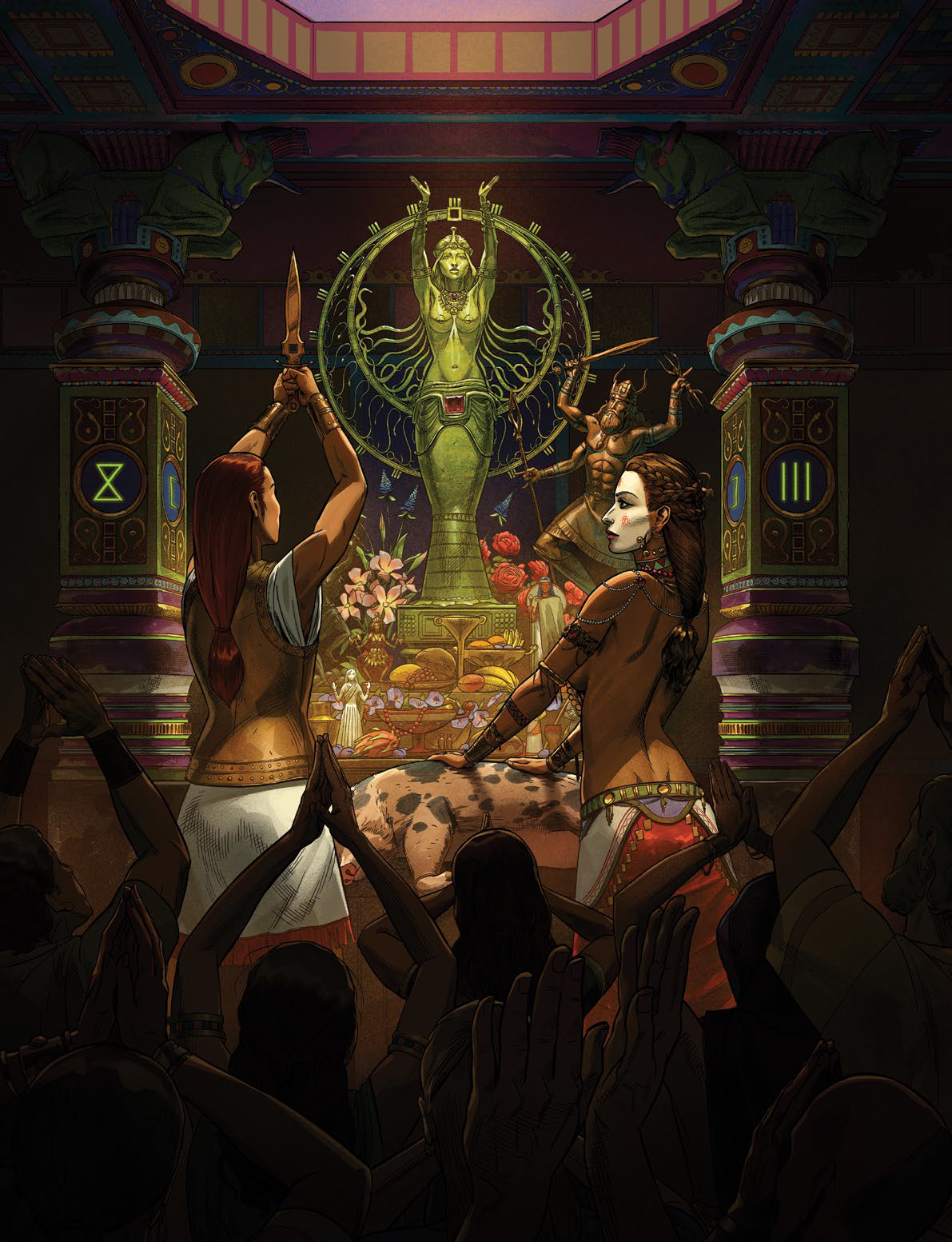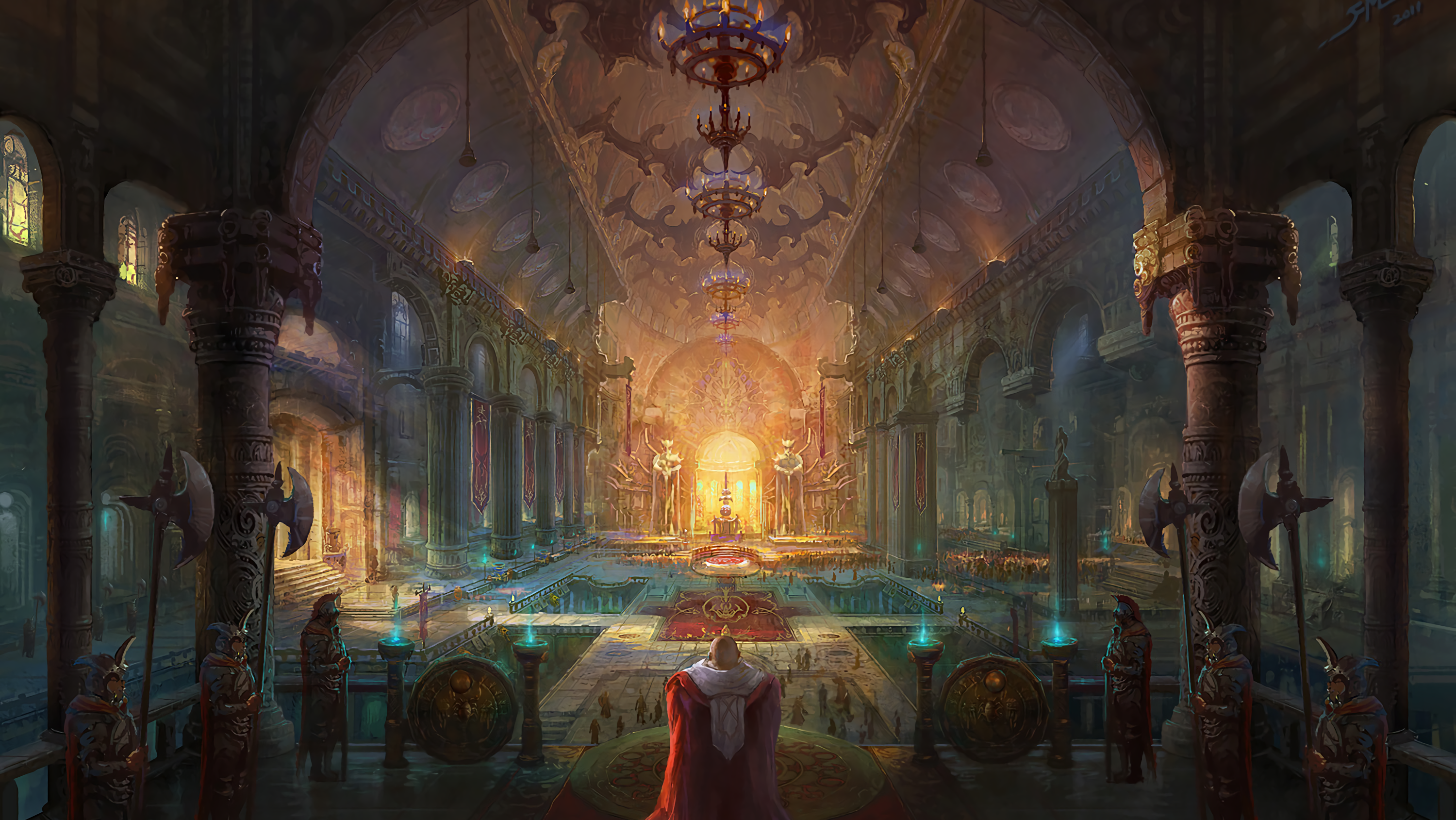Gods and Other Deities
Many are the Gods and Goddesses who lord over the world and its creatures. Beings eternal, capable of summoning powers beyond mortal comprehension, equal only to one another. As ancient as the cosmos itself, their influence often extends to several worlds accross The Omniscape.
Through the passing of the aeons, they solemnly watch the rise and fall of empires, the dawn and dusk of entire worlds. But just as everything else, even they are bound by the most dogmatic law in the universe; the law of necessity.
What could beings such as they, in all their unimaginable might and wisdom, possibly require? The answer is simple. In order for one to be divine, others must be devotees.
All forms of deities share one common characteristic, which is the desire to be worshipped by mortals. They watch over and protect those faithful to them, for it is through their faith that they may continue existing. Without believers, even a deity is bound to slowly wane away, eventually becoming forlorn and forgotten.
Divine Ranks
The divine beings of the multiverse are often categorized according to their cosmic power.Gods
Overgods
Examples: The Creator, Ouroboros, Tharizul
The pinnacle of divinity, the gods who create gods, the arbiters of cosmic law and the unfathombale creators of the multiverse itself. These beings are so enigmatic and removed from reality that most mortals don't even know of their existence. They do not require worship, can't be destroyed and almost never manifest avatars on the material plane.
Greater Deities / True Gods
Greater deities also known as True Gods are beyond mortal understanding. They can’t be summoned, and they are almost always removed from direct involvement in mortal affairs. On very rare occasions they manifest avatars similar to lesser deities, but slaying a true God’s avatar has no effect on the God itself. There are three types of greater deities:
Valara
Examples: Tyr, Chauntera, Vita
The Varala are those gods, who were directly created through the hand and will of The Creator. They came into existence with the purpose of serving as gods and shaping the world in tandem with the Overgods. Some purist scholars view the Varala as the only "true" gods, and both other types as "just" greater deities of the same power level.
Great examples for this are gods like Selûne, Nyx and Vita, who The Creator made so they could watch over Chauntera (Arceiron) and help her grow life.
Mirala
Examples: Khorun, Nerghal, Tzenthis, Valeesha
Unlike the Varala, the Mirala are those gods, who did not get created by The Creator, but came into existence through some other, often more chaotic, way.
Great examples for this are the so called demonic, or chaos gods, Khorun, Nerghal, Tzenthis and Valeesha, who are less persons and more personifications of human emotions. Tharizul might have had a hand in their creation, but even if this is true, they would never be considered Valara.
Ascended
Examples: Babylon, Nemeia
Ascended gods are those gods, who did not begin their existence as gods or even as deities at all. They are often times angels, demons, devils, fey or mortals who have ascended to godhood, either through absorbing a divine spark or by being ascended through the hands of another god.
Lesser Deities
Examples: -
Lesser deities are embodied somewhere in the planes. Some lesser deities live in the Material Plane, others live on the Outer Planes. Such deities can be encountered by mortals, sometimes even in their true form, without manifesting an avatar, at least outside of the material plane. Their power is much more focused on specialized aspects and tasks, than the broader portfolios the more powerful gods are tasked with.
Quasi-deties
Quasi-deities have a divine origin , but they don’t hear or answer prayers, grant spells to clerics, or control aspects of mortal life. They are still immensely powerful beings, and in theory they could ascend to Godhood if they amassed enough worshipers. Quasi-deities fall into several subcategories
Archons
Examples: Raven Queen, Denithria
Very similar in their nature and power to lesser deities, but lacking the divine spark to be considered true gods, Archons are beings of immense power, which has been granted to through a sliver of divinity, and that comes with some sort of task. All Archons have been tasked with a particular duty, which they must fulfill, hoping to one day be granted godhood and true dominion over this aspect.
Demigods
Examples: Mishka Grommarsdotir
Demigods are born from the union of a deity and a mortal being. They have some divine attributes, but their mortal parentage makes them the weakest quasi-deities.
Titans
Examples: Leta
Titans are the divine creations of deities. They might be birthed from the union of two deities, manufactured in a divine forge, born from the blood spilled by a God, or otherwise brought about through divine will or substance.
Vestiges
Examples: -
Vestiges are deities who have lost nearly all their worshipers and are considered dead, from a mortal perspective. Esoteric rituals can sometimes contact these beings and draw on their latent power.
Other Divine Beings
There are many divine origins and beings that rival the power of the gods, sometimes even that of Greater Deities, but that do not posses the Divine Spark, that enables them to become a true god.Archangels
Examples: Magnos, Raccani, Thysra
Celestials are powerful outsiders, typically of good alignment, and the cosmological counterpart to fiends. Just as fiends, celestials come from many different origins.
While the term "angel" and especially Archangel properly referrs to a subset of celestials, those on the Material Plane helped by any celestial being might claim to have been "visited by an angel.
Archdevils
Examples: Babylon, Belial, Moloch
The Archdevils are the strongest form of devils, but they are not a type of devil but a rank in their society. Archdevils are the rulers of The Nine Hells. They were also called the Archdukes of Hell, and the Lords of Hell.
Each archdevil is a unique devil of immense power and influence, with his own resources: military, magical, and political, to rely on in the endless scheming that characterizes devilish politics.
Archfey
Examples: Titania, Mab, Oberon
Archfey are fey beings who gained great power and established a position of preeminence among fey-kind. Each archfey has a unique appearance and set of abilities. Most control a portion of The Feywild and have self-proclaimed titles.
Some archfey are regarded as deities and grant divine abilities to their worshipers. Archfey can be contacted by a willing warlock to form a fey pact.
The most powerful archfey are usually part of a Fey Court.
Archprimals
Archprimals are constructs of concentrated Astral Energy, made manifest by the force of will.
Primals, unlike Primordials, usually came into being after the war between Gods and Primordials had already been settled. They were formed from elemental chaos or manifested through the combined will of primal species. Some also formed out of wild magic or similar substances.
Many primals are revered as gods by primitive or savage species and through their faith are blessed with more and more godly powers.
Archomentals
Examples: Ogrémoch, Ramuh, Ymix
Archomentals are a subset of Primals, that manifested purely out of chaotic elemental energy. Some legends say that they were born from lost primordial essence, which the embodiments of their elements lost during the war against the gods.
Bestial Primals
Examples: Garuda, Ifrit, Leviathan
Bestial Primals are constructs of concentrated elemental made manifest, in the form of mythical creatures, by the will of a primal and savage species, worshiping them like gods. Due to the nature of their existence, a Bestial Primal must consume energy from its surroundings, thus becoming a threat to the world, if summoned to Arceiron.
Kami
Examples: Fu Leng, Shenlong, Sun Daici
Kami are the spirits, phenomena or "holy powers" that are venerated in the various religions, but many that of the Jade Pantheon , alongside the "true" gods. They can be elements of the landscape, forces of nature, as well as beings and the qualities that these beings express.
Demon Lords
Examples: Orcus, Graz'zt, Arcanthera
Demon Lords, also known as Abyssal lords, were archfiends who gained great power and established a position of preeminence among demonkind. Over millennia, these demons have amassed tremendous power and authority over their domain.
Elder Evil / Great Old Ones
Examples: Aztharoth, Nyarlat, Hadar, Shelah
Elder Evils are ancient, powerful, and generally evil beings or entities. Their power can rival, or even surpass, that of demigods, such that they are able to destroy an entire world. The beings knows as the Great Old Ones are the most powerful and ancient of these entities, believed to be even older than all known creation.
Primordials
Examples: Acaeli, Korruth, Sutomterra, Vistishior
The Primordials, or Dawn Titans, are god-like beings made of manifest entropy and elemental energy, who existed before the creation of Arceiron, the Material Plane. Most of them reside within the Elemental Chaos or their own Planes of Existence.
Some primordials are feared, even by the gods, while others have chosen to take up the mantle of godhood and joined one or several pantheons.
Saints
Examples: Rashima, Xerphalim
Saints are either former Archangels or sometimes evern former mortals, who have ascended to the highest rank of celestial beings. Saints are of similar power, maybe even a bit greater power, when compared to demon lords and archdevils.
Spheres of Influence
Attempting to comprehend the true nature of a divine being is considered to be a task in vain. Maybe this is why their interpretations differ so much, according to the religious codices and mythology of each culture.
It is widely believed is that, though eternal, the powers of the deities are sustained through the faith their believers place in them. Without the devotion of their worshippers, they would be left powerless to protect them, or attain the sacred purposes they desire to see fullfilled. So, the deities watch over the faithful, whilst the faithful worship them in return.
Due to this state of mutual dependency, each deity’s divine aspect has been coincided with a cosmic force of the universe, or a particular mortal attribute. These aspects are known as divine domains, and a deity may be associated with either one or more of them.
The Mortal Instruments
Though not always, the divine domains a deity is affiliated with usually define the moral values of their worshippers, as well as the manner in which their faith becomes expressed. A domain’s core principles dictate the rules which the faithful are bound to follow in order to satisfy or appease the will of their deity.
The rituals performed to honor a deity in this manner are known as offerings. The faithful pledge offerings to the deities in order to attract their attention or earn their favor. In a not so dissimilar manner, one may intentionaly or unintentionaly offend a deity through an action that insults the ways of its faith. Such an act is known as a sacrilege. The faithful believe that the divine beings often respond to their offerings by gracing them with their divine blessings, while smiting down those who commit acts of sacrilege against their faith by cursing them with divine banes.




Comments